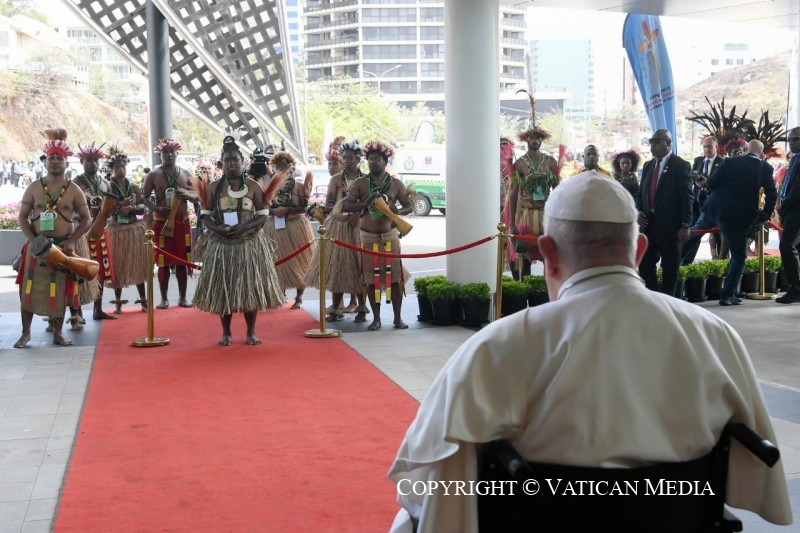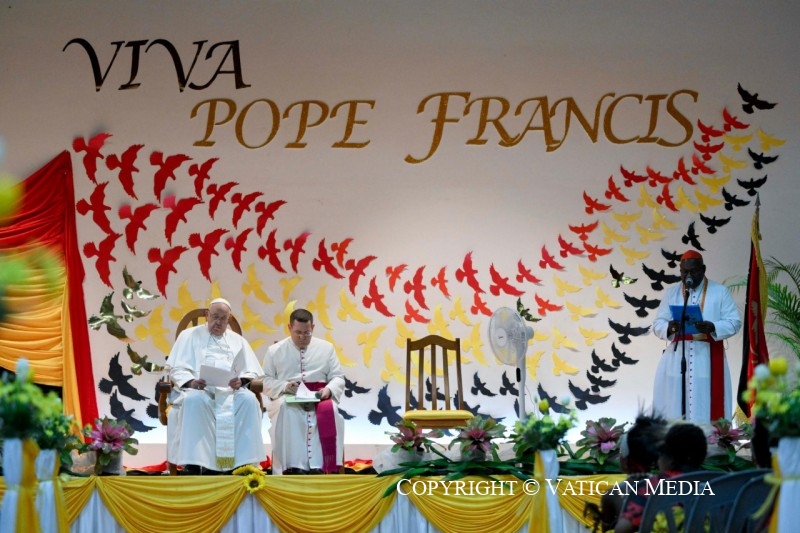(ZENIT News / Port Moresby, 09.07.2024).- On the second day of his visit to Papua New Guinea, Pope Francis focused on building bridges between the Church, local authorities, and the community. His agenda included significant diplomatic exchanges, heartwarming moments with children and the vulnerable, and a gathering with the Church’s faithful.

Strengthening Diplomatic Ties with Local Leaders
Pope Francis began his day with a private Mass before heading to Port Moresby’s Government House to meet with Sir Bob Bofeng Dadae, Governor General of Papua New Guinea. Their exchange, which took place in the grand ceremonial hall, marked a continuation of the Vatican’s diplomatic efforts to foster peace and collaboration in the Pacific region. The Pope signed the Book of Honor and exchanged gifts, symbolizing mutual respect and goodwill.
Following this private audience, the Pope moved to APEC Haus for a broader meeting with civil society, local authorities, and the diplomatic corps. Greeted by the rhythmic performance of the Motu Koitabu tribe, Pope Francis was gifted a traditional wooden boat, embodying the deep cultural heritage of the region. In his address to leaders, diplomats, and community representatives, Pope Francis underscored the importance of unity, social justice, and care for the most vulnerable. His message resonated with the diverse audience, as he called for a collaborative approach to tackling global challenges like climate change, poverty, and inequality.
The Pope’s symbolic gestures, including greeting indigenous children and listening to traditional music, highlighted his commitment to cultural inclusion and his ability to connect with people across backgrounds.

Compassionate Outreach to the Youth
In the afternoon, Pope Francis shifted his attention to some of Papua New Guinea’s most vulnerable, visiting children from Street Ministry and Callan Services at the Caritas Technical Secondary School. Welcomed by Archbishop John Ribat and the school’s director, the Pope was presented with floral offerings from children dressed in vibrant traditional attire.
The visit was marked by moments of joy and warmth, as the children shared stories, asked the Pope questions, and performed cultural dances. In return, Pope Francis offered words of encouragement, emphasizing the importance of education, kindness, and hope in overcoming life’s challenges. His interaction with these young people reflected his deep pastoral care for those on the margins, embodying his broader mission to extend compassion and solidarity to all.

The children, many of whom come from difficult backgrounds, were visibly moved by the Pope’s presence and words, leaving a lasting impression of the Church’s role in nurturing hope and providing support to the disadvantaged.
A Moment with the Church’s Shepherds
Concluding his day, Pope Francis visited the Shrine of Mary Help of Christians to meet with bishops, clergy, religious, seminarians, and catechists from Papua New Guinea and the Solomon Islands. This gathering, set in a spiritual environment, allowed the Pope to reinforce the importance of unity, service, and perseverance in the mission of the Church.
Archbishop John Ribat and Bishop Otto Separy, among other leaders, welcomed the Pope with a traditional floral offering. As the Pope made his way through the shrine, hymns filled the air, creating an atmosphere of reflection and reverence. In his address, Pope Francis encouraged the Church’s ministers to continue their work with humility and dedication, reminding them of their vital role in guiding the faithful and fostering community.

The event also featured testimonies from priests, religious leaders, and catechists, providing a platform for dialogue on the Church’s future in the region. The Pope’s emphasis on synodality—the theme of the ongoing global Synod—highlighted the Church’s collective journey of discernment and collaboration.
As the day ended, Pope Francis left a profound mark on both the local leadership and the faithful, reaffirming his commitment to building a Church that is close to its people, attentive to the needs of the world, and open to dialogue and action in the service of peace.
A Legacy of Compassion and Engagement
Pope Francis’ visit to Papua New Guinea was a testament to his leadership’s guiding principles: diplomacy, compassion, and faith. By engaging with political leaders, vulnerable children, and the Church’s clergy, the Pope demonstrated his unique ability to connect with diverse groups, offering a message of hope, unity, and service. His presence in this Pacific nation will be remembered as a moment of grace, with echoes of his words likely to influence both civil and religious spheres for years to come.
Thank you for reading our content. If you would like to receive ZENIT’s daily e-mail news, you can subscribe for free through this link.




